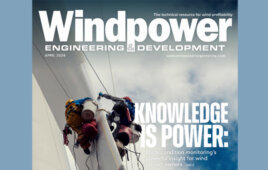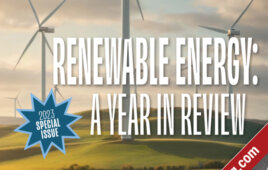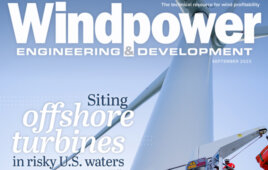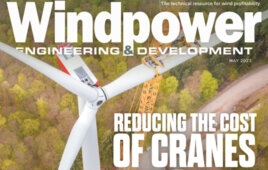A few observations on the progress of offshore wind
ast October, our founding editor Paul Dvorak wrote an editorial on the developing offshore wind industry in United States (go to tinyurl. com/AFewObservations for a refresher). This issue, we revisit a few of his observations to assess the industry’s progress over the last year.
The good news? The offshore wind development pipeline in the country includes more than 25,000 MW of planned generating capacity, with 2,000 MW expected to be operational within five years. Currently, Massachusetts is calling for 1,600 MW of new offshore wind energy by 2027, New York is planning for 2,400 MW by 2030, and New Jersey set the biggest goal of 3,500 MW by 2030.
Those are lofty goals and, as Dvorak pointed out in his editorial, there is a lot yet to learn. One idea is to take advantage of European experience, an approach that’s attracted New York offshore wind proponents. The New York Power Authority (NYPA) aims to study effective offshore wind transmission models by focusing on large-scale European projects. NYPA says best practices and lessons learned from European electrical infrastructure design and transmission networks will guide the state’s procurements of offshore wind.
Another advancement coming from overseas: larger turbines.
Think big. MHI Vestas Offshore Wind recently made it official: its V164 wind turbine has achieved a 10-MW power rating and is ready to buy. The turbine manufacturer says it has already installed more than 100 of its early-model V164 in the UK and Germany and recently pushed the boundaries of its flexible 8-MW platform.
MHI Vestas credits “a stronger gearbox, some minor mechanical upgrades, and a small design change to enhance airflow and increase cooling in the converter” for the 10-MW victory. The ability to produce more power from a single wind turbine means fewer turbines are needed at a project site — and that means lower capital, construction, and O&M costs.
Earlier this year, GE said it’s investing more than $400 million over the next few years to develop the 12-MW Haliade-X. This turbine is expected to tower some 260 meters (853 ft) over the sea and produce 45% more energy than any other offshore turbine available to date. Its 107-m (351-ft) long blades will be longer than the size of a soccer field.
Think jobs. “Any offshore wind farm should be as much a job creator for the U.S. as a power generator,” Dvorak wrote last year. If current research is accurate, jobs will be aplenty when new offshore wind construction begins. Take South Carolina, for example. According to a new report from the American Jobs Project, the state has the 45th-lowest labor force participation rate in the nation and workforce barriers have contributed to a poverty rate of over 15%.
However, offshore wind development could mean nearly 850 jobs for local citizens in the state. The report recommends the offshore industry tap into South Carolina’s research expertise, manufacturing sector, and logistics infrastructure (learn more at tinyurl.com/SouthCarolinaJobs). A similar economic analysis found that offshore wind would bring closer to 5,000 jobs to five different Atlantic Coast states — including South Carolina — while adding billions to the American economy (read more on page 6 of this issue).
Think cost. One caveat to offshore wind success in the United States is that costs must drop, substantially. The country’s first and only offshore wind farm south of Block Island, R.I. cost some $300 million for a total of 30 MW and five turbines. However, pricing for America’s first large-scale offshore wind farm presented at a record low. The 800-MW Vineyard Wind project, planned for south of Martha’s Vineyard, set a national record with prices at $74 per megawatt-hour in the project’s first year (and a second phase would cost merely $65/MWh).
Granted, every project is different but Vineyard Wind suggests the industry is headed in the right direction. Dvorak also mentioned that the future is floating, and his instincts were correct. Floating foundations let wind farms be sited further from shore and in deeper waters with stronger wind. Northern California recently submitted a lease application for floating offshore wind (see page 11). Fingers crossed floating wind farms bring a new offshore sector to the country. We’ll see what the next year has in store.
Well wishes in your retirement, Paul Dvorak. We miss your wisdom at Windpower Engineering & Development.
Michelle Froese
Editor
mfroese@wtwhmedia.com
Filed Under: Digital issues




